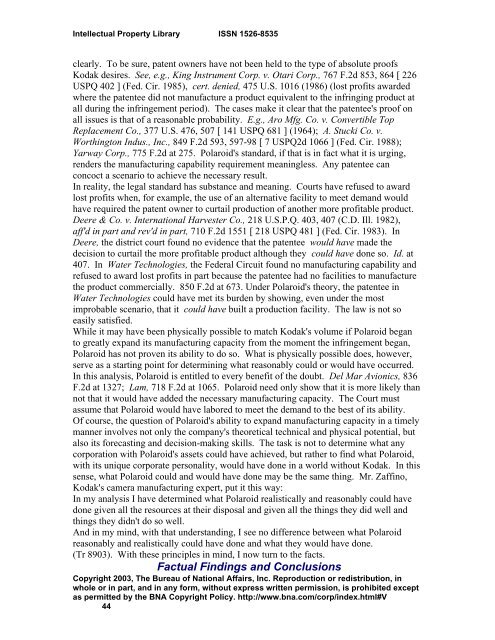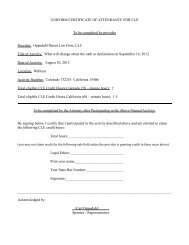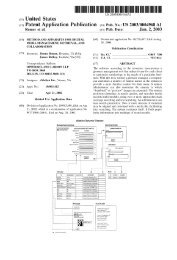Polaroid Corp. v. Eastman Kodak Co. - Oppedahl Patent Law Firm LLC
Polaroid Corp. v. Eastman Kodak Co. - Oppedahl Patent Law Firm LLC
Polaroid Corp. v. Eastman Kodak Co. - Oppedahl Patent Law Firm LLC
You also want an ePaper? Increase the reach of your titles
YUMPU automatically turns print PDFs into web optimized ePapers that Google loves.
Intellectual Property Library ISSN 1526-8535<br />
clearly. To be sure, patent owners have not been held to the type of absolute proofs<br />
<strong>Kodak</strong> desires. See, e.g., King Instrument <strong><strong>Co</strong>rp</strong>. v. Otari <strong><strong>Co</strong>rp</strong>., 767 F.2d 853, 864 [ 226<br />
USPQ 402 ] (Fed. Cir. 1985), cert. denied, 475 U.S. 1016 (1986) (lost profits awarded<br />
where the patentee did not manufacture a product equivalent to the infringing product at<br />
all during the infringement period). The cases make it clear that the patentee's proof on<br />
all issues is that of a reasonable probability. E.g., Aro Mfg. <strong>Co</strong>. v. <strong>Co</strong>nvertible Top<br />
Replacement <strong>Co</strong>., 377 U.S. 476, 507 [ 141 USPQ 681 ] (1964); A. Stucki <strong>Co</strong>. v.<br />
Worthington Indus., Inc., 849 F.2d 593, 597-98 [ 7 USPQ2d 1066 ] (Fed. Cir. 1988);<br />
Yarway <strong><strong>Co</strong>rp</strong>., 775 F.2d at 275. <strong>Polaroid</strong>'s standard, if that is in fact what it is urging,<br />
renders the manufacturing capability requirement meaningless. Any patentee can<br />
concoct a scenario to achieve the necessary result.<br />
In reality, the legal standard has substance and meaning. <strong>Co</strong>urts have refused to award<br />
lost profits when, for example, the use of an alternative facility to meet demand would<br />
have required the patent owner to curtail production of another more profitable product.<br />
Deere & <strong>Co</strong>. v. International Harvester <strong>Co</strong>., 218 U.S.P.Q. 403, 407 (C.D. Ill. 1982),<br />
aff'd in part and rev'd in part, 710 F.2d 1551 [ 218 USPQ 481 ] (Fed. Cir. 1983). In<br />
Deere, the district court found no evidence that the patentee would have made the<br />
decision to curtail the more profitable product although they could have done so. Id. at<br />
407. In Water Technologies, the Federal Circuit found no manufacturing capability and<br />
refused to award lost profits in part because the patentee had no facilities to manufacture<br />
the product commercially. 850 F.2d at 673. Under <strong>Polaroid</strong>'s theory, the patentee in<br />
Water Technologies could have met its burden by showing, even under the most<br />
improbable scenario, that it could have built a production facility. The law is not so<br />
easily satisfied.<br />
While it may have been physically possible to match <strong>Kodak</strong>'s volume if <strong>Polaroid</strong> began<br />
to greatly expand its manufacturing capacity from the moment the infringement began,<br />
<strong>Polaroid</strong> has not proven its ability to do so. What is physically possible does, however,<br />
serve as a starting point for determining what reasonably could or would have occurred.<br />
In this analysis, <strong>Polaroid</strong> is entitled to every benefit of the doubt. Del Mar Avionics, 836<br />
F.2d at 1327; Lam, 718 F.2d at 1065. <strong>Polaroid</strong> need only show that it is more likely than<br />
not that it would have added the necessary manufacturing capacity. The <strong>Co</strong>urt must<br />
assume that <strong>Polaroid</strong> would have labored to meet the demand to the best of its ability.<br />
Of course, the question of <strong>Polaroid</strong>'s ability to expand manufacturing capacity in a timely<br />
manner involves not only the company's theoretical technical and physical potential, but<br />
also its forecasting and decision-making skills. The task is not to determine what any<br />
corporation with <strong>Polaroid</strong>'s assets could have achieved, but rather to find what <strong>Polaroid</strong>,<br />
with its unique corporate personality, would have done in a world without <strong>Kodak</strong>. In this<br />
sense, what <strong>Polaroid</strong> could and would have done may be the same thing. Mr. Zaffino,<br />
<strong>Kodak</strong>'s camera manufacturing expert, put it this way:<br />
In my analysis I have determined what <strong>Polaroid</strong> realistically and reasonably could have<br />
done given all the resources at their disposal and given all the things they did well and<br />
things they didn't do so well.<br />
And in my mind, with that understanding, I see no difference between what <strong>Polaroid</strong><br />
reasonably and realistically could have done and what they would have done.<br />
(Tr 8903). With these principles in mind, I now turn to the facts.<br />
Factual Findings and <strong>Co</strong>nclusions<br />
<strong>Co</strong>pyright 2003, The Bureau of National Affairs, Inc. Reproduction or redistribution, in<br />
whole or in part, and in any form, without express written permission, is prohibited except<br />
as permitted by the BNA <strong>Co</strong>pyright Policy. http://www.bna.com/corp/index.html#V<br />
44





